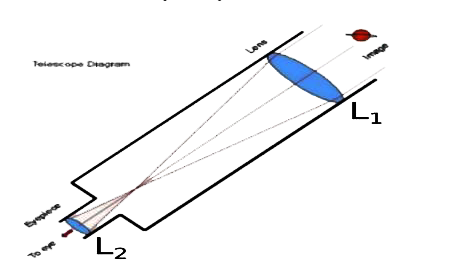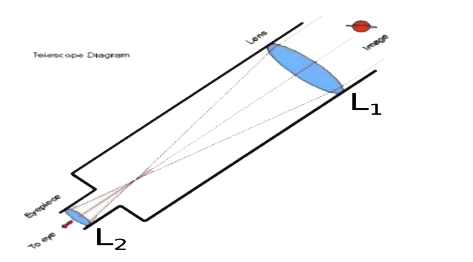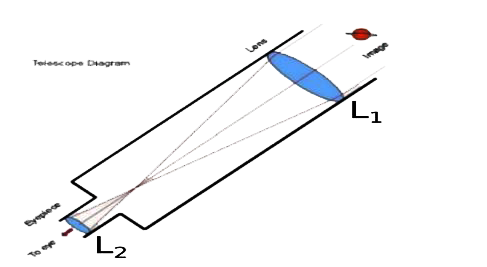A Keplerian telescope with magnification T=15 was submerged into water which filled up the inside of the telescope. To make the system work as a telescope again within the former dimensions, the objective was replaced. What has the magnification of the telescope become equal to ? the refractive index of the glass of which the ocular is made is equal to n=1.50.
When a glass lens is immersed in water its focal length increase approximately four times. We check this as follows as :
1f'a=(n−1)(1R1−1R2)
1fw=(1n0−1)(1R1−1R2)=1n0−1n−1.1fa=n−n0n0(n−1)1fa
Now back to the problem. originally in air
T=f0fe=15 so l=f0+fe=fe(T+1)
In water, f'e=n0(n−1)n−n0fe
and the focal length of the replaced objective is given by the condition
f'0+f'e=l=(T+1)fe
or f'0=(T+1)fe−f'e
Hence T'=f'0f'0=(T+1)n−n0n0(n−1)−1
Subsituation gives (n=1.5,n0=1.33),T'=3.09
Topper's Solved these Questions
- OPTICSBook:IE IRODOV, LA SENA & SS KROTOVChapter:OPTICSExercise:Interference Of Light
Explore 33 Videos
- OPTICSBook:IE IRODOV, LA SENA & SS KROTOVChapter:OPTICSExercise:Diffraction Of Light
Explore 60 Videos
- MECHANICSBook:IE IRODOV, LA SENA & SS KROTOVChapter:MECHANICSExercise:Mechanics Problems
Explore 92 Videos
- OSCILLATIONS AND WAVESBook:IE IRODOV, LA SENA & SS KROTOVChapter:OSCILLATIONS AND WAVESExercise:Electromagnetic Waves, Radiation
Explore 36 Videos
Similar Questions
A telescope with magnification M = 15 was submerged in water so that the inside of the telescope is filled up with water. To make the system work as a telescope within the former dimensions, the objective was removed. What was the magnification of the telescope after the change? μ of the material of the eye-piece=1.5 and μ of water =43
View SolutionA giant refracting telescope at an observatory has an objective lens of focal length15cm.If an eye piece of focal length 1.0cm is used What is the angular magnification of the telescope ?
View Solution
Knowledge Check
Sumati wanted to see the stars of the night sky. She knows that she needs a telescope to see those distant stars. She finds out that the telescopes, which are made of lenses, are called refracting telescopes and the ones which are made of mirrors are called reflecting telescopes.

So she decided to make a refracting telescope. She bought two lenses, L1 and L2. out of which L1 was bigger and L2 was smaller. The larger lens gathers and bends the light, while the smaller lens magnifies the image. Big, thick lenses are more powerful. So to see far away, she needed a big powerful lens. Unfortunately, she realized that a big lens is very heavy. Heavy lenses are hard to make and difficult to hold in the right place. Also since the light is passing through the lens, the surface of the lens has to be extremely smooth. Any flaws in the lens will change the image. It would be like looking through a dirty window.
Sumati did some preliminary experiment with the lenses and found out that the magnification of the eyepiece (L2) is 3. If in her experiment with L2 she found an image at 24 cm from the lens, at what distance did she put the object?A72 cmB12 cmC8 cmD6 cmSumati wanted to see the stars of the night sky. She knows that she needs a telescope to see those distant stars. She finds out that the telescopes, which are made of lenses, are called refracting telescopes and the ones which are made of mirrors are called reflecting telescopes.

So she decided to make a refracting telescope. She bought two lenses, L1 and L2. out of which L1 was bigger and L2 was smaller. The larger lens gathers and bends the light, while the smaller lens magnifies the image. Big, thick lenses are more powerful. So to see far away, she needed a big powerful lens. Unfortunately, she realized that a big lens is very heavy. Heavy lenses are hard to make and difficult to hold in the right place. Also since the light is passing through the lens, the surface of the lens has to be extremely smooth. Any flaws in the lens will change the image. It would be like looking through a dirty window.
What is the formula for magnification obtained with a lens?ARatio of height of image to height of objectBDouble the focal lengthCInverse of the radius of curvature.DInverse of the object distanceSumati wanted to see the stars of the night sky. She knows that she needs a telescope to see those distant stars. She finds out that the telescopes, which are made of lenses, are called refracting telescopes and the ones which are made of mirrors are called reflecting telescopes.

So she decided to make a refracting telescope. She bought two lenses, L1 and L2. out of which L1 was bigger and L2 was smaller. The larger lens gathers and bends the light, while the smaller lens magnifies the image. Big, thick lenses are more powerful. So to see far away, she needed a big powerful lens. Unfortunately, she realized that a big lens is very heavy. Heavy lenses are hard to make and difficult to hold in the right place. Also since the light is passing through the lens, the surface of the lens has to be extremely smooth. Any flaws in the lens will change the image. It would be like looking through a dirty window.
Sumati bought not-so-thick lenses for the telescope and polished them. What advantages, if any, would she have with her choice of lenses?AShe will not have any advantage as even thicker lenses would give clearer images.BThicker lenses would have made the telescope easier to handleCNot-so-thick lenses would not make the telescope very heavy and also allow considerable amount of light to pass.DNot-so-thick lenses will give her more magnification
A giant refracting telescope at an observatory has an objective lens of focal length15cm.If an eye piece of focal length 1.0cm is used What is the angular magnification of the telescope ?
View SolutionA Galilean telescope of 10-fold magnification has the length of 45cm when adjusted to infinity. Determine :
(a) the focal lengths of the telescope's objective and ocular,
(b) by what distance the ocualr should be displaced to adjust the telescope to the distance of 50m.
View SolutionAt what magnification T of a telescope with a diameter of the objective D=6.0cm is the illuminance of the image of an object on the retina not less than without the telescope ? The pupil diameter is assumed do be equal to d0=3.0mm. The losses of light in the telescope are negligible.
View SolutionSumati wanted to see the stars of the night sky. She knows that she needs a telescope to see those distant stars. She finds out that the telescopes, which are made of lenses, are called refracting telescopes and the ones which are made of mirrors are called reflecting telescopes.

So she decided to make a refracting telescope. She bought two lenses, L1 and L2. out of which L1 was bigger and L2 was smaller. The larger lens gathers and bends the light, while the smaller lens magnifies the image. Big, thick lenses are more powerful. So to see far away, she needed a big powerful lens.Unfortunately, she realized that a big lens is very heavy. Heavy lenses are hard to make and difficult to hold in the right place. Also since the light is passing through the lens, the surface of the lens has to be extremely smooth. Any flaws in the lens will change the image. It would belike looking through a dirty window.
Based on the diagram shown, what kind of lenses would Sumati need to makethe telescope?
View SolutionSumati wanted to see the stars of the night sky. She knows that she needs a telescope to see those distant stars. She finds out that the telescopes, which are made of lenses, are called refracting telescopes and the ones which are made of mirrors are called reflecting telescopes.

So she decided to make a refracting telescope. She bought two lenses, L1 and L2. out of which L1 was bigger and L2 was smaller. The larger lens gathers and bends the light, while the smaller lens magnifies the image. Big, thick lenses are more powerful. So to see far away, she needed a big powerful lens.Unfortunately, she realized that a big lens is very heavy. Heavy lenses are hard to make and difficult to hold in the right place. Also since the light is passing through the lens, the surface of the lens has to be extremely smooth. Any flaws in the lens will change the image. It would be like looking through a dirty window.
If the powers of the lenses L1 and L2 are in the ratio of 4:1, what would be the ratio of the focal length of L1 and L2
View Solution